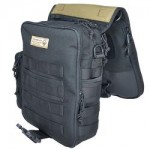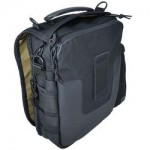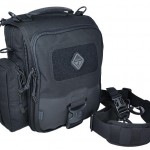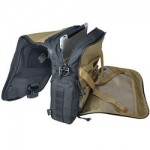Emily and I sipping historic tea at the Boston Tea Party Museum.
Author: Richard
Cape Cod
We have started our 4th of July trip by hanging out on the beaches at Cape Cod in New England. Continue reading Cape Cod
Modular Messenger Bag
I have been thinking about designing a modular messenger bag for my trip to the east coast next month. A few years ago, I made a tactical vest for my Nerf guns as part of a 24 hour Zombie Nerf game I was attending. I used it for the last two years and I love how much gear I can carry with it. Also, the modular pouch design is really nice so that you can always tailor the vest for the mission you are on.
Unfortunately, people who walk around with a tactical vest on tend to get some odd looks, to say the least. So I have thought about doing something like the vest, but in more of a backpack type of form factor. The idea would be to create a minimalist messenger bag that is covered with the same 1/2″ nylon webbing used for military vests and armor. The only permanent compartments would be a padded laptop pocket inside of a thinner than usual messenger pouch. Other compartments can be added to the 1/2″ nylon mesh as needed.
Here are a few examples of what I would like to do:
Kato Tactical iPad Messenger Bag
I do like the look of this bag, though is is not quite as modular as I would want. I do rather like the vertical orientation of this bag though.
Multicam messenger bag
This is most like what I am thinking of for my bag. Likely not as thick as this one, but it is rather the same thing that I have in mind. I would like for the part that attaches the bag to the shoulder straps to be more triangular and go from the bottom left to the top right of the bag.
By using the standard 1/2 nylon mesh, I could easily just pick up some pouches at my neighborhood army surplus shop. However, I do have plans to create custom pouches that integrate wearable tech into the bag.
I may end up installing wires into the bag that are attached to metal snaps, one for power and ground, so that you could snap into any of them for power. To prevent a short, I should install a set of snaps attached to some nylon webbing next to each power drop. That way i can just snap them onto the power drop to cover any unused connections.
Here are a few examples of what I would like to do:
Solar power pack:
- This is something that I have been wanting to try for a while. It would be classified as a power modal that includes a flexible solar panel, a battery charger, high capacity Li Poly Battery, and a voltage booster. Basically you are using solar power to run all of your stuff while you walk around in the sun, and the battery when the sun goes down. https://learn.adafruit.com/solar-boost-bag
-
Wireless cell phone charging:
- Using an induction coil, that is stitched into a cellphone sized pouch, you drop your phone in and it starts charging. I may have to install a 9V booster to run the induction coil, but it this may just work. https://learn.adafruit.com/cell-phone-charging-purse/overview
-
Music controllers:
- By deconstructing something like this I can create some capacitive touch pads for controlling music from my cell phone. The touch pads could be 3D printed with graphene filament, or it could be made with carbon fiber fabric.
-
Wireless server:
- Setting up a raspberry pi to be a wireless LAN file server. This is rather a stretch goal, but something that I have done before.
Super Low Budget Wearable Tech
I love doing wearable electronics and the price of entry for making wearable tech is supper low. Anyone can make something cool with the Adafruit GEMMA for about $20. However, my work with STEM Paths presents the challenge of trying to create an interesting project with a shoestring budget.
So, with that in mind, I give you my plan for the ~$2 wearable electronics kit. Well… this dose not include the price of conductive thread, and it dose require some pre soldering for the sensor… but $2 for a kit that will light up 6 LEDs when the lights go out.
So here is how I plan to do it:
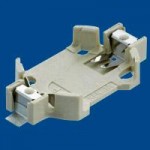 I found this lovely battery holder on Mouser that has the perfect holes for stitching to fabric.
I found this lovely battery holder on Mouser that has the perfect holes for stitching to fabric.- Then I found these $0.08 LEDs in Red, Green, and Yellow.
- That is enough to make a light up wearable, but I really want this kit to do something other than just turn on when a battery is added.
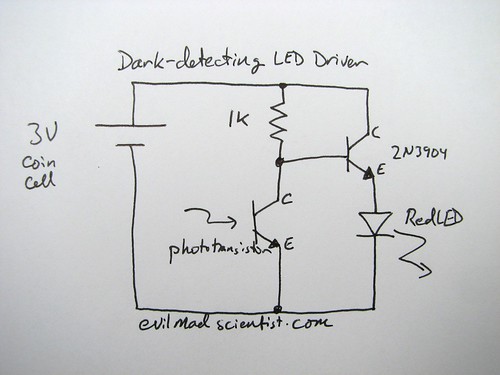 Thanks to Evil Mad Scientist, I added a phototransistor, NPN transistor, and a 1K resistor that will create an ambient light sensor. So now the LEDs will only light up when it is dark or during the night time.
Thanks to Evil Mad Scientist, I added a phototransistor, NPN transistor, and a 1K resistor that will create an ambient light sensor. So now the LEDs will only light up when it is dark or during the night time.
Click the URL for a full list of parts that can be ordered from Mouser.com
http://www.mouser.com/ProjectManager/ProjectDetail.aspx?AccessID=8a33709065
Bag Making resources
This is mostly to remind me of some old resources for hardware.
http://hookandloop.com/
http://www.hitexcorp.com/
http://gear.orgxiii.org/product-category/zippers/30-giant-zippers/
Self driving vehicles will change our cities
Tyler Folsom is the Elcano Project Affiliate Professor for University of Washington. By now we should all see how much self driving cars will change our cities. Tyler is working on ways to make that transition in a practical way.
Changes to the infrastructure and development of low price sensors will be the key.
UAVs and the farm
Gabriel Torres is representing MicaSense. They are working on the next-generation sensors for agricultural.
High resolution near infrared spectral imaging can clearly show a change in crop health even before visible signs appear. Comparison of data can easily show where change is taking place.
Wireless power and lasers
Tom Nugent, from LaserMotive Inc., talked about using lasers to transfer power from the ground to an airborne drone. Initially this will be for security and military applications, but they aim to make this tech available to smaller commercial companies.





